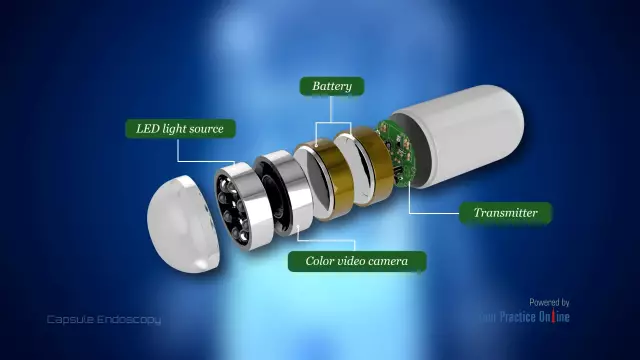- Author Rachel Wainwright [email protected].
- Public 2023-12-15 07:39.
- Last modified 2025-11-02 20:14.
Palin
Palin: instructions for use and reviews
- 1. Release form and composition
- 2. Pharmacological properties
- 3. Indications for use
- 4. Contraindications
- 5. Method of application and dosage
- 6. Side effects
- 7. Overdose
- 8. Special instructions
- 9. Application during pregnancy and lactation
- 10. Use in childhood
- 11. In case of impaired renal function
- 12. For violations of liver function
- 13. Use in the elderly
- 14. Drug interactions
- 15. Analogs
- 16. Terms and conditions of storage
- 17. Terms of dispensing from pharmacies
- 18. Reviews
- 19. Price in pharmacies
Latin name: Palin
ATX code: J01MB04
Active ingredient: pipemidic acid (Pipemidic acid)
Manufacturer: Lek d.d. (Lek dd) (Slovenia)
Description and photo update: 2019-21-08
Prices in pharmacies: from 499 rubles.
Buy

Palin is an antibacterial agent from the quinolone group, urological antiseptic, active against some gram-positive and gram-negative bacteria.
Release form and composition
Palin is available in the form of capsules: opaque, with a white body (yellowish tint is possible) and a green cap, size No. 1; contents - hygroscopic powder from white to almost white with a yellowish tinge color (10 capsules in a blister, 2 blisters in a cardboard box).
Active ingredient: pipemidic acid (in the form of trihydrate), its content in 1 capsule is 200 mg.
Additional components: corn starch, magnesium stearate, colloidal silicon dioxide.
The composition of the capsule shell:
- Body: titanium dioxide (E171), gelatin, sunset yellow dye (E110);
- Cap: titanium dioxide (E171), gelatin, patented blue dye (E131), sunset yellow dye (E110), brilliant black dye (E151), quinoline yellow dye (E104).
Pharmacological properties
Pharmacodynamics
The active ingredient of Palin is pipemidic acid, an antibacterial agent from the quinolone group, used in the treatment of urinary tract infections caused by sensitive pathogens.
The mechanism of action of the drug is due to the ability to suppress bacterial DNA topoisomerase II, as a result of which the bacterial DNA is disintegrated.
Palin has a bactericidal effect against gram-positive bacteria Staphylococcus aureus and most gram-negative microorganisms, including Pseudomonas aeruginosa, Proteus mirabilis, Escherichia coli, Proteus vulgaris, Neisseria spp. and Klebsiella pneumoniae.
The drug has no effect on anaerobic microorganisms.
Pharmacokinetics
After oral administration, pipemidic acid is rapidly and almost completely (93%) absorbed. The maximum concentration in serum after taking a dose of 400 mg is reached within 70-80 minutes and is 3.5 μg / ml. Biological availability - 30-60%.
The connection with plasma proteins depends on the concentration in the blood serum and is approximately 30%. The volume of distribution is 1.7 l / kg. High concentrations of pipemidic acid are generated in the kidneys, urine and prostate fluid. The drug crosses the placental barrier and, in small amounts, into breast milk.
Pipemidic acid is excreted mainly by the kidneys by glomerular filtration and tubular secretion unchanged in the urine (up to 85% of the received dose of the drug is determined in the daily urine dose). The total clearance is 6.3 ml / min. The half-life is 2-3 hours. The elimination of the drug directly depends on the creatinine clearance. With impaired renal function, the concentration of pipemidic acid in the plasma is higher than in healthy volunteers, and the half-life also increases to 5.7-16 hours.
Indications for use
According to the instructions, Palin is a drug intended for the treatment of infectious and inflammatory diseases of the urinary tract (acute and chronic) caused by microorganisms sensitive to its active substance:
- Inflammation of the bladder;
- Inflammation of the urethra;
- Inflammation of the prostate gland;
- Pyelonephritis.
For preventive purposes, Palin is used to prevent the development of infections during instrumental interventions in gynecological and urological practice.
Contraindications
- Severe liver dysfunction (including cirrhosis);
- Severe renal dysfunction (creatinine clearance less than 10 ml / min);
- Porphyrin disease;
- Diseases of the central nervous system, accompanied by a low seizure threshold;
- Age under 14;
- Pregnancy and breastfeeding;
- Hypersensitivity to any component of the drug.
Carefully:
- Elderly age (over 70 years old);
- Epilepsy;
- Convulsions;
- Disorders of cerebral circulation (including cerebral vasospasm and cerebral hemorrhage) in the history of the disease.
Instructions for use of Palina: method and dosage
Palin capsules are indicated for oral administration before meals.
Usually prescribed 200 mg (1 capsule) 2 times a day at 12-hour intervals (morning and evening). The duration of treatment is determined individually. Kidney disease usually takes 3 to 6 weeks, and prostatitis 6-8 weeks.
In staphylococcal infections, the daily dose is increased to 600 mg - 1 capsule 3 times a day at intervals of 8 hours. The duration of therapy is on average 10 days, if necessary, the course is extended.
Side effects
- From the digestive system: diarrhea, nausea, gastralgia, vomiting; rarely - pseudomembranous colitis, accompanied by severe diarrhea;
- Allergic reactions: skin rash, mild itching, malignant exudative erythema;
- From the side of the central and peripheral nervous system: very rarely - sleep disorders, confusion, agitation, headache, hallucinations, visual disturbances, sensory disturbances, tremors, depression, convulsions; in some cases - large seizures;
- From the hematopoietic system: in some cases - eosinophilia; in patients with glucose-6-phosphate dehydrogenase deficiency, hemolytic anemia; in the elderly and patients with impaired renal function - thrombocytopenia;
- Others: superinfection, resistance, photosensitivity.
Overdose
Cases of development of life-threatening side effects in overdose have not been reported. Nausea and vomiting, headache, dizziness, tremors, confusion, and convulsions may occur.
If no more than 4 hours have passed since the reception of Palin, gastric lavage and intake of activated charcoal are recommended. There is no specific antidote for pipemidic acid. With the development of undesirable effects from the central nervous system (including epileptiform seizures), symptomatic therapy (diazepam) is prescribed. To accelerate the elimination of the drug from the body, you can use forced diuresis.
special instructions
Palin can contribute to obtaining a false positive urine glucose reaction when conducting a study using Fehling's solution or Benedict's reagent. It is recommended to use enzymatic reactions with glucose oxidase.
During treatment, patients should receive plenty of drink (under the control of diuresis), avoid ultraviolet radiation, refrain from driving and performing any type of work that requires quick psychophysical reactions and increased attention.
With caution, Palin should be used to treat patients with a history of allergic reactions to quinolones, since there is a possibility of cross-sensitivity.
With long-term therapy, it is necessary to monitor the general blood counts, the functional state of the kidneys and liver, and also periodically determine the sensitivity of microflora to pipemidic acid.
Influence on the ability to drive vehicles and complex mechanisms
It is recommended to be careful when driving vehicles or complex machinery. In the event of the development of side effects from the central nervous system, one should refrain from performing potentially hazardous activities that require increased attention, speed of mental and motor reactions.
Application during pregnancy and lactation
The safety of using pipemidic acid during pregnancy and lactation has not been studied. Palin is contraindicated for use in pregnant women. If treatment is necessary during lactation, you should decide with your doctor about stopping breastfeeding.
Pediatric use
Palin is prohibited for use for the treatment of children under the age of 14.
With impaired renal function
Palin should be used with caution in the treatment of patients with impaired renal function with creatinine clearance of 10-30 ml / min. The dose of the drug should be adjusted and the patient's condition should be constantly monitored.
In severe renal impairment with creatinine clearance less than 10 ml / min, the administration of the drug is contraindicated.
For violations of liver function
The appointment of Palin is contraindicated in case of severe liver dysfunction (including cirrhosis).
Use in the elderly
Palin should be used with caution when treating patients over 70 years of age, as they are more likely to develop side effects.
Drug interactions
Antacids and sucralfate can reduce the absorption of pipemidic acid, therefore, intervals of at least 2-3 hours should be observed between doses.
Combined use slows down the metabolism of caffeine and theophylline.
Pipemidic acid can potentiate the action of nonsteroidal anti-inflammatory drugs, rifampicin, cimetidine, and warfarin.
With simultaneous use of aminoglycosides with Palin, synergism of the bactericidal effect is noted.
Analogs
Palin's analogs are: Vero-Pipemidine, Pimidel, Pilamin, Pipegal, Pipem, Pipelin, Uropimide, Pipemidic acid, Urotractin.
Terms and conditions of storage
Store in a dry place, out of reach of children, at temperatures up to 25 ° C.
The shelf life is 5 years.
Terms of dispensing from pharmacies
Dispensed by prescription.
Reviews about Palin
According to reviews, Palin is an effective antibacterial drug for the treatment of diseases of the urinary tract. It quickly relieves pain and is well tolerated. The disadvantage of the antibiotic is the high total cost of the capsules required for the course of treatment.
In some negative reviews, the development of side effects is mentioned.
Price for Palin in pharmacies
The approximate price for Palin is 252-290 rubles. for 20 capsules of 200 mg.
Palin: prices in online pharmacies
|
Drug name Price Pharmacy |
|
Palin 200 mg capsule 20 pcs. RUB 499 Buy |

Anna Kozlova Medical journalist About the author
Education: Rostov State Medical University, specialty "General Medicine".
Information about the drug is generalized, provided for informational purposes only and does not replace the official instructions. Self-medication is hazardous to health!






